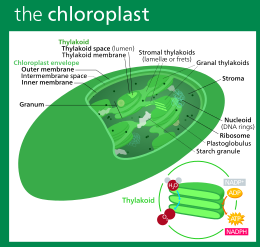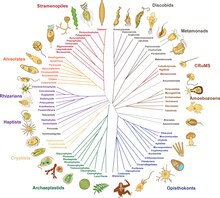Eukaryote
| Eukaryota Temporal range: Statherian–Present
| |
|---|---|
| Scientific classification | |
| Domain: | Eukaryota (Chatton, 1925) Whittaker & Margulis, 1978 |
| Supergroups and kingdoms[2] | |
| |
| Synonyms | |
The eukaryotes (
The eukaryotes seemingly emerged within the
Eukaryotic cells contain
Diversity
Eukaryotes are organisms that range from microscopic single cells, such as picozoans under 3 micrometres across,[6] to animals like the blue whale, weighing up to 190 tonnes and measuring up to 33.6 metres (110 ft) long,[7] or plants like the coast redwood, up to 120 metres (390 ft) tall.[8] Many eukaryotes are unicellular; the informal grouping called protists includes many of these, with some multicellular forms like the giant kelp up to 200 feet (61 m) long.[9] The multicellular eukaryotes include the animals, plants, and fungi, but again, these groups too contain many unicellular species.[10] Eukaryotic cells are typically much larger than those of prokaryotes—the bacteria and the archaea—having a volume of around 10,000 times greater.[11][12] Eukaryotes represent a small minority of the number of organisms, but, as many of them are much larger, their collective global biomass (468 gigatons) is far larger than that of prokaryotes (77 gigatons), with plants alone accounting for over 81% of the total biomass of Earth.[13]
- Eukaryotes range in size from single cells to organisms weighing many tons
The eukaryotes are a diverse lineage, consisting mainly of
Distinguishing features
Nucleus
The defining feature of eukaryotes is that
Biochemistry
Eukaryotes differ from prokaryotes in multiple ways, with unique biochemical pathways such as sterane synthesis.[21] The eukaryotic signature proteins have no homology to proteins in other domains of life, but appear to be universal among eukaryotes. They include the proteins of the cytoskeleton, the complex transcription machinery, the membrane-sorting systems, the nuclear pore, and some enzymes in the biochemical pathways.[22]
Internal membranes
Eukaryote cells include a variety of membrane-bound structures, together forming the
The nucleus is surrounded by a double membrane known as the
Vesicles may be specialized; for instance, lysosomes contain digestive enzymes that break down biomolecules in the cytoplasm.[29]
Mitochondria

Mitochondria contain
Some eukaryotes, such as the metamonads Giardia and Trichomonas, and the amoebozoan Pelomyxa, appear to lack mitochondria, but all contain mitochondrion-derived organelles, like hydrogenosomes or mitosomes, having lost their mitochondria secondarily.[35] They obtain energy by enzymatic action in the cytoplasm.[36][35]
Plastids

Plants and various groups of
Cytoskeletal structures
The cytoskeleton provides stiffening structure and points of attachment for motor structures that enable the cell to move, change shape, or transport materials. The motor structures are microfilaments of actin and actin-binding proteins, including α-actinin, fimbrin, and filamin are present in submembranous cortical layers and bundles. Motor proteins of microtubules, dynein and kinesin, and myosin of actin filaments, provide dynamic character of the network.[40][41]
Many eukaryotes have long slender motile cytoplasmic projections, called flagella, or multiple shorter structures called cilia. These organelles are variously involved in movement, feeding, and sensation. They are composed mainly of tubulin, and are entirely distinct from prokaryotic flagella. They are supported by a bundle of microtubules arising from a centriole, characteristically arranged as nine doublets surrounding two singlets. Flagella may have hairs (mastigonemes), as in many Stramenopiles. Their interior is continuous with the cell's cytoplasm.[42][43]
Centrioles are often present, even in cells and groups that do not have flagella, but conifers and flowering plants have neither. They generally occur in groups that give rise to various microtubular roots. These form a primary component of the cytoskeleton, and are often assembled over the course of several cell divisions, with one flagellum retained from the parent and the other derived from it. Centrioles produce the spindle during nuclear division.[44]
Cell wall
The cells of plants, algae, fungi and most chromalveolates, but not animals, are surrounded by a cell wall. This is a layer outside the cell membrane, providing the cell with structural support, protection, and a filtering mechanism. The cell wall also prevents over-expansion when water enters the cell.[45]
The major
Sexual reproduction
Eukaryotes have a life cycle that involves
The
Evolution

History of classification
In
The eukaryotes thus came to be seen as four kingdoms:- Kingdom Protista
- Kingdom Plantae
- Kingdom Fungi
- Kingdom Animalia
The protists were at that time thought to be "primitive forms", and thus an evolutionary grade, united by their primitive unicellular nature.[59] Understanding of the oldest branchings in the tree of life only developed substantially with DNA sequencing, leading to a system of domains rather than kingdoms as top level rank being put forward by Carl Woese, Otto Kandler, and Mark Wheelis in 1990, uniting all the eukaryote kingdoms in the domain "Eucarya", stating, however, that "'eukaryotes' will continue to be an acceptable common synonym".[3][61] In 1996, the evolutionary biologist Lynn Margulis proposed to replace Kingdoms and Domains with "inclusive" names to create a "symbiosis-based phylogeny", giving the description "Eukarya (symbiosis-derived nucleated organisms)".[4]
Phylogeny
By 2014, a rough consensus started to emerge from the phylogenomic studies of the previous two decades.
| Eukaryotes |
| ||||||||||||||||||||||||||||||||||||||||||||||||||||||
| 2200 mya |
One view of the great kingdoms and their stem groups.
Origin of eukaryotes

The origin of the eukaryotic cell, or eukaryogenesis, is a milestone in the evolution of life, since eukaryotes include all complex cells and almost all multicellular organisms. The
An endosymbiotic union between a motile anaerobic archaean and an aerobic alphaproteobacterium gave rise to the LECA and all eukaryotes, with mitochondria. A second, much later endosymbiosis with a cyanobacterium gave rise to the ancestor of plants, with chloroplasts.[67]
The presence of eukaryotic biomarkers in archaea points towards an archaeal origin. The genomes of
Fossils
The timing of the origin of eukaryotes is hard to determine but the discovery of Qingshania magnificia, the earliest multicelluar eukaryote from North China which lived during 1.635 billion years ago, suggests that the crown group eukaryotes would have originated from the late Paleoproterozoic (Statherian); the earliest unequivocal unicellular eukaryotes which lived during approximately 1.65 billion years ago are also discovered from North China: Tappania plana, Shuiyousphaeridium macroreticulatum, Dictyosphaera macroreticulata, Germinosphaera alveolata, and Valeria lophostriata.[74]
Some acritarchs are known from at least 1.65 billion years ago, and a fossil, Grypania, which may be an alga, is as much as 2.1 billion years old.[75][76] The "problematic"[77] fossil Diskagma has been found in paleosols 2.2 billion years old.[77]
Structures proposed to represent "large colonial organisms" have been found in the
The presence of
Whenever their origins, eukaryotes may not have become ecologically dominant until much later; a massive increase in the zinc composition of marine sediments 800 million years ago has been attributed to the rise of substantial populations of eukaryotes, which preferentially consume and incorporate zinc relative to prokaryotes, approximately a billion years after their origin (at the latest).[89]
See also
- Eukaryote hybrid genome
- List of sequenced eukaryotic genomes
- Parakaryon myojinensis
- Vault (organelle)
References
- ^ S2CID 254436650.
- ^ PMID 30257078.
- ^ PMID 2112744.
- ^ PMID 8577716.
- PMID 37316666.
- PMID 23555709.
- ISBN 978-0-85112-235-9.
- ^ Earle CJ, ed. (2017). "Sequoia sempervirens". The Gymnosperm Database. Archived from the original on 1 April 2016. Retrieved 15 September 2017.
- ISBN 0-521-30419-9. Archivedfrom the original on 10 February 2023. Retrieved 7 April 2023.
- ^ PMID 24789819.
- ISBN 9780123847201.
- ^ Yamaguchi M, Worman CO (2014). "Deep-sea microorganisms and the origin of the eukaryotic cell" (PDF). Japanese Journal of Protozoology. 47 (1, 2): 29–48. Archived from the original (PDF) on 9 August 2017.
- PMID 29784790.
- ^ S2CID 204545629.
- (PDF) from the original on 14 March 2023. Retrieved 8 April 2023.
- (PDF) from the original on 25 July 2014. Retrieved 8 April 2023.
- S2CID 11961888.
- ^ Harper, Douglas. "eukaryotic". Online Etymology Dictionary.
- S2CID 31259189.
- ^ O'Connor, Clare (2008). "Chromosome Segregation: The Role of Centromeres". Nature Education. Retrieved 18 February 2024.
eukar
- ^ PMID 10446042.
- PMID 11805300.
- ISBN 978-94-007-1533-2. Archivedfrom the original on 29 May 2016. Retrieved 27 October 2015.
- ISBN 978-0-19-963851-2.
- PMID 32317144.
- PMID 20300205.
- ^ "Endoplasmic Reticulum (Rough and Smooth)". British Society for Cell Biology. Archived from the original on 24 March 2019. Retrieved 12 November 2017.
- ^ "Golgi Apparatus". British Society for Cell Biology. Archived from the original on 13 November 2017. Retrieved 12 November 2017.
- ^ "Lysosome". British Society for Cell Biology. Archived from the original on 13 November 2017. Retrieved 12 November 2017.
- PMID 32166015.
- ISBN 978-0471214953.
- ^ Mack S (1 May 2006). "Re: Are there eukaryotic cells without mitochondria?". madsci.org. Archived from the original on 24 April 2014. Retrieved 24 April 2014.
- PMID 18620004.
- ISBN 978-0-8053-9614-0.
- ^ PMID 27185558.
- ^ Davis JL (13 May 2016). "Scientists Shocked To Discover Eukaryote With NO Mitochondria". IFL Science. Archived from the original on 17 February 2019. Retrieved 13 May 2016.
- ISBN 978-1-4020-4060-3.
- PMID 18518896.
- S2CID 24613863.
- ISBN 978-0-8153-3218-3. Archivedfrom the original on 8 March 2019. Retrieved 6 April 2023.
- PMID 29716949.
- PMID 12624192.
- PMID 11743094.
- PMID 3294718.
- ISBN 978-0-19-511183-5.
- .
- ISBN 978-1-4051-3277-0.
- PMID 15809414.
- PMID 21714941.
- S2CID 9441768.
- ^ S2CID 17013247.
- ^ PMID 18663385.
- PMID 19359589.
- PMID 21429931.
- Wikidata Q123558544.
- ^ Moore RT (1980). "Taxonomic proposals for the classification of marine yeasts and other yeast-like fungi including the smuts". Botanica Marina. 23: 361–373.
- ^ Goldfuß (1818). "Ueber die Classification der Zoophyten" [On the classification of zoophytes]. Isis, Oder, Encyclopädische Zeitung von Oken (in German). 2 (6): 1008–1019. Archived from the original on 24 March 2019. Retrieved 15 March 2019. From p. 1008: "Erste Klasse. Urthiere. Protozoa." (First class. Primordial animals. Protozoa.) [Note: each column of each page of this journal is numbered; there are two columns per page.]
- PMID 10943416. Archived from the original(PDF) on 14 June 2011.
- ^ from the original on 4 February 2020. Retrieved 4 February 2020.
- PMID 5762760.
- PMID 1585174.
Eucarya, or eukaryotes
- PMID 26817772.
- ^ PMID 29360967.
- from the original on 2 February 2024. Retrieved 20 December 2021.
- S2CID 233328713.
- S2CID 254436650.
- ^ ISBN 978-0-521-76131-4. Archivedfrom the original on 24 March 2019. Retrieved 27 August 2017.
- S2CID 236916203.
- S2CID 67790751.
- S2CID 218710816.
- PMID 33767194.
- PMID 23895660.
- PMID 36544020.
- PMID 38266082.
- PMID 1631544.
- PMID 16754612.
- ^ .
- S2CID 4331375.
- S2CID 258360867.
- .
- S2CID 257761993.
- PMID 19416859.
- ^ Ward P (9 February 2008). "Mass extinctions: the microbes strike back". New Scientist. pp. 40–43. Archived from the original on 8 July 2008. Retrieved 27 August 2017.
- PMID 25918387.
- S2CID 205258987.
- S2CID 205254122.
- PMID 27446030.
- PMID 34131078.
- PMID 29869832.



